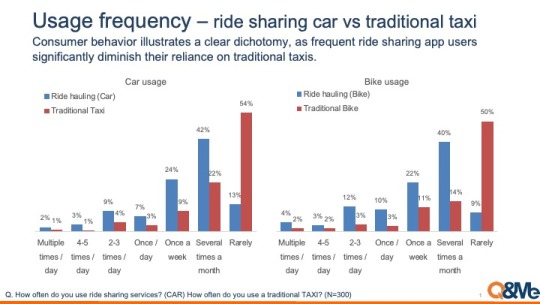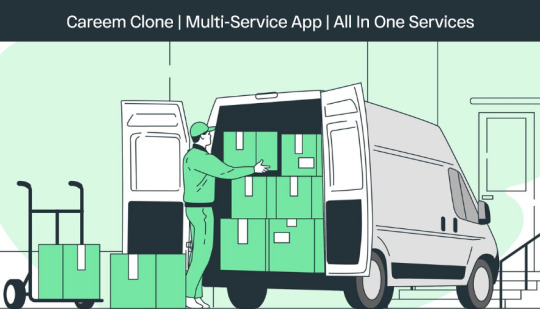#ride hailing
Video
youtube


Toyota Boshoku MX221 Concept, 2023. One of two autonomous ride hailing concepts to be presented by the Toyota subsidiary at the CES. This one has 4 seats in a reconfigurable interior (MX Prime/MX Plus/MX Pass) with seating that can face each other or be replaced by a wheelchair. The cabin can be configured with 2 high-tech chairs featuring power recline and leg rests with a deployable table, keyboard and screen
#youtube#Toyota Boshoku#Toyota Boshoku MX221#autonomous#evolution#electric vehicle#robotaxi#driverless#ride hailing#CES#2023#concept#prototype#sliding doors#transport system#futuristic
89 notes
·
View notes
Text
The Newfoundland and Labrador government is planning changes to the Highway Traffic Act, including scrapping test requirements for some drivers, to encourage ride-hailing services like Uber to operate in the province.
At a news conference Monday, Service N.L. Minister Sarah Stoodley said drivers with a Class 5 licence for passenger vehicles or light trucks will no longer need to do a written or road test to get a Class 4 licence, required to drive a taxi or for a ride-hailing service.
"This will help to ease the administrative process for both new taxi and ride-sharing drivers, and speed up the process to recruit and retain and get more drivers on the road," Stoodley said.
Full article
Tagging: @politicsofcanada
#cdnpoli#canada#canadian politics#canadian news#canadian#newfoundland and labrador#newfoundland & labrador#driving#taxis#ride-sharing#driving tests#ride hailing
11 notes
·
View notes
Text

Talixo clone script for Ride-Hailing startups
If you're looking to start a ride-hailing business, the Talixo clone script is the perfect solution for you. This script is uniquely designed to help you launch your startup quickly and efficiently. With Talixo clone script, you'll be able to provide your customers with a top-notch ride-hailing experience, while also ensuring that your business operates smoothly. Don't wait any longer to make your dream a reality - get started with the Talixo clone script today!
#ride hailing#ride sharing#talixo#app development#car sharing#taxi app#taxi software#talixo clone app#talixo clone script#uber like taxi app#taxi dispatch software#taxi management software#cab dispatch system
0 notes
Text
How Xanh SM Won 2nd Position in Vietnam's Ride-Hailing Market
The ride-hailing landscape in Vietnam is undergoing a swift transformation, marked by evolving consumer preferences and the entry of new players that are rapidly reshaping market dynamics. Among these, Xanh SM's ascent to the second position in the sector is a narrative of strategic differentiation and consumer-centric innovation. This column delves into the multifaceted approach that propelled Xanh SM to its current stature, highlighting the insights gleaned from a comprehensive study involving 300 ride-hailing users in Vietnam.
The Evolving Landscape of Ride-Hailing in Vietnam
The Vietnamese ride-hailing market is on a fast track of change, driven by technological advancements and shifting consumer behaviors. Our research, encompassing 300 ride-hailing service users, reveals insightful trends about the current usage patterns and brand positioning within the sector. This foundational understanding sets the stage for a deeper examination of the market dynamics and the factors influencing consumer choices.
Ride-hailing selected due to ease-of-booking
The data paints a clear picture of the integral role ride-hailing services, both cars and motorbikes, play in the daily lives of Vietnamese consumers. With over 40% of respondents using car-hailing services weekly and 50% opting for motorbike hailing, the convenience and accessibility of these services are undeniable.

Users overwhelmingly cite the ease of booking and the diversity of available vehicle types as key advantages, underscoring the value proposition of ride-hailing platforms over traditional transportation methods. Yet, a notable 39% perceive no distinct benefits of conventional vehicles over ride-hailing options, pointing towards a significant shift in consumer perceptions.

Xanh SM in the 2nd brand position after Grab
In the competitive arena of Vietnam's ride-hailing market, Grab continues to hold the reins with a significant majority of users favoring the platform. However, the emergence of Xanh SM as a strong contender for the second position, as indicated by 52% of respondents having used its services in the past year, signals a shifting market dynamic. The company's ability to capture a 19% share as the most preferred service is indicative of its growing influence and market penetration.

The ascendancy of Xanh SM can be attributed to its superior customer satisfaction scores, a testament to the company's focus on service quality and user experience. A closer analysis reveals two critical areas where Xanh SM outperforms its competitors: driver professionalism and vehicle cleanliness. Unlike its rivals, Xanh SM employs full-time drivers, ensuring consistent service standards, and utilizes the latest VinFast EV cars, enhancing the overall customer experience with modern, clean, and eco-friendly vehicles.

The Path Forward for Xanh SM
Xanh SM's strategic differentiation, characterized by a focus on driver professionalism and vehicle quality, has laid a robust foundation for its early successes in the competitive ride-hailing landscape. However, the sustainability of this approach, given the high fixed costs associated with employing full-time staff and investing in cutting-edge EV technology, remains a critical consideration. As Xanh SM navigates the challenges of scaling its operations and maintaining profitability, the industry will keenly observe its ability to sustain its competitive edge while managing the substantial investments that have fueled its initial growth.
In conclusion, Xanh SM's rise to prominence in Vietnam's ride-hailing market is a narrative of strategic innovation and a deep understanding of consumer needs. As the market continues to evolve, the ability of new entrants like Xanh SM to challenge established players will hinge on their adaptability, customer-centric strategies, and the sustainable management of operational costs.
0 notes
Text
How a Careem Clone App Can Transform Your Taxi Booking Service?

The taxi industry has witnessed a significant revolution with the advent of on-demand taxi booking services. In this digital age, taxi booking service providers are increasingly adopting Careem clone apps to transform their operations and stay ahead in the competitive market. This article explores the immense potential and benefits of implementing a Careem clone app for taxi booking services. From enhancing the user experience to streamlining operations and expanding reach, we delve into the key features, development process, and strategies to overcome challenges for a successful transformation in the taxi industry.
Introduction to the Careem Clone App
What is a Careem Clone App?
A Careem clone app is a customized taxi booking application that replicates the functionality and features of the popular ride-hailing service, Careem. It allows businesses to create their own on-demand taxi booking platform and provide a seamless and efficient service to their customers.
Rise of On-Demand Taxi Booking Services
On-demand taxi booking services have revolutionized the way people travel. Gone are the days of waving down a taxi on the street or waiting for hours to find a cab. With the rise of platforms like Careem, Uber, and Lyft, customers can now book a ride with just a few taps on their smartphones. This convenience and ease of use have made on-demand taxi booking services immensely popular among users.
Why Consider a Careem Clone App for Your Taxi Booking Service?
Implementing a Careem clone app for your taxi booking service can bring numerous benefits to your business. It allows you to leverage the success and proven business model of a trusted platform like Careem, while also having the flexibility to customize and tailor it to fit your specific requirements and branding. This can help you stay ahead of the competition and provide an exceptional user experience to your customers.
Benefits of Implementing a Careem Clone App for Taxi Booking Service
Increased Efficiency and Productivity
A Careem clone app automates and streamlines various processes involved in taxi booking, dispatch, and fleet management. This leads to increased efficiency and productivity for your business.
Enhanced Customer Satisfaction
Providing a seamless and convenient booking experience is essential for customer satisfaction. A Careem clone app offers a user-friendly interface that allows customers to easily book rides, track their drivers in real time, and make hassle-free payments.
Cost Savings and Revenue Generation
Implementing a Careem clone app can also lead to cost savings and revenue generation opportunities. The automation and optimization of processes can help reduce operational costs, such as fuel consumption and idle time.
Enhancing User Experience with a Careem Clone App
User-Friendly Interface Design
A Careem clone app prioritizes user experience by offering a simple and intuitive interface design. This ensures that users can easily navigate through the app, find the necessary information, and complete the booking process without any confusion or frustration.
Seamless Booking and Payment Process
The Careem clone app streamlines the booking and payment process, allowing users to book a ride with just a few taps and make cashless transactions. By integrating popular payment gateways and ensuring secure transactions, you can create a seamless and hassle-free experience that users will appreciate.
Real-Time Tracking and Notifications
One of the key features of a Careem clone app is real-time tracking and notifications. Users can track the location of their assigned driver in real-time and receive notifications regarding the driver's arrival, estimated time of arrival, and other relevant updates. This transparency and communication help build trust and improve the overall user experience.
Streamlining Operations through a Careem Clone App
Automated Dispatch and Allocation System
With the automated dispatch and allocation system of a Careem clone app, you can efficiently assign drivers to incoming ride requests based on their availability, location, and other parameters.
Efficient Fleet Management
You can track the location of your entire fleet in real-time, monitor driver behavior, and manage maintenance schedules. This allows you to proactively address any issues, optimize operations, and ensure the smooth running of your taxi service.
Data Analytics and Business Intelligence
A Careem clone app can provide valuable insights into your business through data analytics and business intelligence tools. By analyzing data related to user preferences, booking patterns, and driver performance, you can make data-driven decisions, identify areas for improvement, and optimize your operations to maximize profitability.
So, if you're looking to transform your taxi booking service and provide a top-notch user experience, consider implementing a Careem clone app. It can revolutionize the way you operate, increase efficiency, enhance customer satisfaction, and drive your business toward success.
Expanding Reach and Increasing Revenue with a Careem Clone App
Targeting a Larger Customer Base
With a Careem clone app, you have the opportunity to expand your reach and tap into a larger customer base. By providing an intuitive and user-friendly platform, you can attract more customers who are looking for convenient and reliable taxi booking services.
Integration with Marketing and Promotional Strategies
One of the major benefits of a Careem clone app is the ability to integrate it with your marketing and promotional strategies. With push notifications, in-app advertisements, and loyalty programs, you can keep your customers engaged and informed about any promotional offers or discounts you may be running.
Monetization Opportunities
A Careem clone app opens up various monetization opportunities for your taxi booking service. By exploring these monetization avenues, you can maximize your earnings and make your app a profitable venture.
Key Features and Functionality of a Careem Clone App
Registration and Profile Management
A Careem clone app should include a seamless registration process that allows users to create an account quickly and easily. Additionally, users should be able to manage their profiles, update personal information, and track their ride history within the app.
Booking and Ride Request
Users should be able to select their pickup and drop-off locations, choose the type of vehicle they require, and get an estimated fare before confirming their request.
Rating and Review System
To ensure the quality of service, a Careem clone app should have a rating and review system. Both passengers and drivers should be able to rate each other and provide feedback after the completion of a ride.
Driver-Partner Management
Efficient driver-partner management is crucial for the success of a Careem clone app. The app should include features for driver registration, document verification, and vehicle inspection. It should also provide tools for managing driver availability, tracking earnings, and facilitating seamless communication between drivers and passengers.
Developing and Launching a Careem Clone App
Choosing the Right Development Approach
When developing a Careem clone app, you have the option to choose between building it from scratch or using a ready-made clone script. Assess your specific requirements, budget, and time constraints to determine the best approach for your business.
Hiring a Reliable Development Team
To ensure a successful app development, it is crucial to hire a reliable and experienced development team. Look for developers who have expertise in building on-demand taxi booking apps and have a proven track record of delivering high-quality projects.
Testing and Quality Assurance
Thorough testing and quality assurance are essential before launching your Careem clone app. Test all features and functionalities rigorously to ensure a seamless user experience. Identify and fix any bugs or glitches to provide a smooth and reliable service to your customers.
App Store Submission and Launch Strategy
Once your app is ready, it's time to submit it to the app stores for approval. Follow the guidelines provided by the respective app stores and create an effective launch strategy to generate buzz and attract users.
Overcoming Challenges and Ensuring Success with a Careem Clone App
Launching a Careem clone app comes with its own set of challenges. However, by continuously improving your app based on user feedback, providing excellent customer support, and being innovative with your marketing strategies, you can overcome these challenges and ensure the success of your taxi booking service.
A Careem clone app can be a game-changer for your taxi booking service. By embracing this innovative technology, you can improve efficiency, enhance user experience, and boost revenue. Additionally, streamlining operations, expanding reach, and overcoming challenges can ensure the success of your taxi business. So, consider implementing a Careem clone app today and unlock the full potential of your taxi booking service in the digital era.
FAQ
How does a Careem clone app benefit passengers?
With a Careem clone app, passengers can enjoy a seamless and convenient taxi booking experience. The app also allows passengers to rate and review their experience, ensuring a high level of service quality.
Can a Careem clone app help taxi service providers optimize their operations?
Absolutely! A Careem clone app streamlines operations for taxi service providers. It offers features like an automated dispatch and allocation system, efficient fleet management, and robust data analytics. These functionalities help optimize resource allocation, reduce idle time, improve overall efficiency, and make data-driven business decisions.
Is it expensive to develop and launch a Careem clone app?
The cost of developing and launching a Careem clone app varies depending on various factors such as the app's features, complexity, platform compatibility, and development team's rates.
How can taxi service providers overcome challenges while implementing a Careem clone app?
Implementing a Careem clone app may come with challenges such as selecting the right development approach, finding a reliable development team, testing and quality assurance, and successfully launching the app. Additionally, having a well-defined launch strategy and marketing plan can help maximize the app's potential and ensure a successful transformation for your taxi booking service.
#careem clone app#careem clone#careem app#careem clone script#careem app clone#app like careem#careem clone app script#ride hailing#all in one services#multi service app
0 notes
Text
Latin America Mobility as a Service Market Analysis by Trends, Size, Share, Growth Opportunities, and Emerging Technologies

The LATAM MaaS industry is projected to experience a substantial rise in the near future, due to population explosion and rapid urbanization, with surging venture capital investments in the MaaS startup companies.
The transport sector is transforming with the emergence of advanced technologies, services, and products.
Mobility as a Service (MaaS) can be defined as the integration of various forms of transport services into a single accessible mobility service on demand. It offers commuters the ease to access mobility services with a single application that provides a single payment channel, mitigating the need for multiple ticketing and payment operations.
A successful MaaS service provides advanced business models and methods to organize and operate various transport options, with benefits such as access to better user and demand information, and new opportunities that cater to the requirement of transport operators.
Access Report Summary - Latin America Mobility as a Service Market Segmentation Analysis Report
The MaaS is aimed to add value to the user, and offer an alternative to private use of the vehicle, that is more convenient, sustainable, and economic. Due to surging urbanization, every city in the world is facing pressure which causes liveability and accessibility issues.
The MaaS service can improve the accessibility and living conditions of both rural and urban areas.
0 notes
Text

Taxi Booking App revolutionizes the way we hail and travel in taxis, offering unparalleled convenience and efficiency. With this innovative app, passengers can experience a seamless and expedient taxi booking process, making their journeys hassle-free and enjoyable.
Visit us: https://www.spotnrides.com/
#uber clone app#uber clone#taxi booking app#business#ride hailing#ride sharing#ondemandappdevelopment#mobile app development#web app development#business coach#taxi business#booking software#technology#travel
0 notes
Text
How Partnerships Can Help Unlock the True Potential of Mobility?
Mobility is a rapidly growing industry shaping how we move and interact with our cities. However, partnerships can unlock the true potential of mobility through collaboration between private companies, public agencies, and other stakeholders.
Despite the burgeoning mobility landscape, many companies need help to achieve tangible returns. One way to overcome this challenge is to engage with other mobility players. New partnerships can help companies tap into new skills, resources, and ideas. And they can allow companies to gain new insights into customer needs and preferences. But these partnerships need to be structured carefully. And they need to address critical issues. If not, an association may fail to deliver on its potential.

Sharing Data
One key way partnerships can help unlock the potential of mobility is by sharing data. Private companies, such as ride-hailing and scooter-sharing firms, have access to valuable data on how people move around cities. This data can be used to improve transportation planning and infrastructure by partnering with public agencies. For example, data on where people are starting and ending their trips can help inform decisions on where to build new bike lanes or bus rapid transit lines.
Developing New Technologies
Another way partnerships can help unlock the potential of mobility is by developing new technologies. Private companies often have the resources to invest in cutting-edge technology, such as autonomous vehicles and automated scheduling softwares. By partnering with public agencies, these technologies can be tested and deployed to benefit the public. For example, advanced features through transit softwares can provide first-mile/last-mile connections to public transit, making it more convenient for people to use.
Expanding Business and Creating Ecosystem
As disruption drives change, companies in at least a dozen industries are rethinking how they do business. Some are creating new business models that leverage technology. Other companies are reinventing themselves as networks and ecosystems. Mobility players are looking to these partnerships to expand their portfolios and meet end-user needs more effectively.
Ecosystems cover the entire value chain, from the customer to the transportation provider. They allow mobility players to build stronger relationships with customers and enable the creation of new revenue streams. They also reduce financial risk and allow players to react quickly to market changes. They are also designed to address critical capability gaps. They can help companies build customer-centric value propositions, which improves their ability to satisfy customer needs and meet consumer expectations.
Connectivity and Future-Oriented Services
Tech-led mobility ecosystems are actively involved in connectivity and future-oriented services, but the depth and breadth of these partnerships may determine their success. These partnerships are usually built with significant up-front thought about roles, governance, and impact measurement. Some ecosystems include all the players needed for a core product, while others may consist of only a few players. In addition, ecosystems may involve a mix of traditional and emerging mobility players.
Upgrading Skills and Technology
The public sector has an important role in building partnership-friendly policy frameworks. The public sector helps mitigate risk, leverage convening power, and encourage investment. The public sector benefits from the skills and technology of the private sector. It also makes public investments in infrastructure. In addition, public sector leaders can help companies find new opportunities in a new country or region. They can help companies understand and meet the needs of new consumers.
In addition to the public sector, companies can also work with social and public sector partners. These partners can help companies gain insight into new markets and develop distribution models for new consumers. They also provide secure multi-year funding. But implementing these partnerships requires coordination across multiple functions within a company. The partnership must also align with a company's corporate goals and government priorities.
The key to mobility players' success is building an ecosystem that can satisfy customer needs. This means thinking about customer needs and preferences, creating an engaging customer experience, and ensuring that the entire value chain provides a satisfying customer experience. As a result, companies can build more resilient future mobility worlds.
In addition, partnerships can help companies reduce supply chain costs. Partnerships can leverage the specialized capabilities of partners, including cost-effective distribution networks.
Increasing Accessibility
Partnerships can also help make mobility more accessible to underserved communities. Private companies can partner with community organizations to provide transportation services in areas currently underserved by traditional transit. This can include providing transportation to jobs, healthcare, and educational opportunities.
Addressing Negative Impacts
Partnerships between the public and private sectors can also help address the negative impacts of mobility, such as congestion and air pollution. By working together, public agencies and private companies can develop solutions that reduce the number of single-occupancy vehicles on the road, reduce vehicle miles travelled (VMT) and encourage the use of sustainable transportation options.
In conclusion, partnerships are crucial for unlocking the true potential of mobility. By sharing data, developing new technologies, increasing accessibility, and addressing negative impacts, partnerships between private companies, public agencies, and other stakeholders can help create a transportation system that is safe, efficient, and sustainable for all.
0 notes
Text
Beat: ¿cuánto pueden ganar sus conductores en la Argentina?
Beat: ¿cuánto pueden ganar sus conductores en la Argentina?
Nuevos tiempos para la empresa de movilidad Beat en el Cono Sur americano. Patricia Jebsen, quien desde 2019 trabaja como gerenta general de Beat Argentina, tomó en septiembre el liderazgo del mercado chileno, y pasó a ser la gerenta general de Beat Argentina y Chile.
(more…)

View On WordPress
#américa latina#Argentina#Beat#Beat Argentina#Beat Argentina y Chile#Beat Zero#Buenos Aires#CBU#conductores#Cono Sur#CVU#Hans Hanckes#iProfesional#Patricia Jebsen#ride hailing
0 notes
Text
BUS LANES: Why can taxis use Bus Lanes and what does the future hold in terms of access?
How do YOU see taxi future access in your region?
https://www.taxi-point.co.uk/post/bus-lanes-why-can-taxis-use-bus-lanes-and-what-does-the-future-hold-in-terms-of-access

0 notes
Text
ryan bergara preposterous rumors thread
too many nipples
he ate paul rudd
two left feet
cannibalistic remains in his 2018 malibu california home
#???#going through my drafts is always a wild ride 😭#watcher#watcher entertainment#all hail the watcher#ryan bergara#bfu#buzzfeed unsolved
215 notes
·
View notes
Text

THE BOY!!!!!! id in alts (src from weibo)
#dont think anyone's posted this yet; its a car taxi (think uber) service ad#sits here waiting for a possible transparent of this art#my son......#gaming#ga-ming#嘉明#gaming genshin#genshin impact#official genshin content#ramblings!#id in alts#oh. that type of service is called ride hailing. i mindblanked.
64 notes
·
View notes
Text

Careem Clone | Multi-Service App | All In One Services
Develop a white-label solution like Careem app to enhance your business revenue. Our Careem clone script is fully customizable. Get the best super app today!
#careem clone app#careem clone#careem app#careem clone script#careem app clone#app like careem#careem clone app script#ride hailing#all in one services#multi service app
0 notes
Text
Latin America Mobility as a Service Market Share, Growing Demand, and Top Key Players
The LATAM MaaS industry is projected to experience a substantial rise in the near future, due to population explosion and rapid urbanization, with surging venture capital investments in the MaaS startup companies.
The transport sector is transforming with the emergence of advanced technologies, services, and products.
Mobility as a Service (MaaS) can be defined as the integration of various forms of transport services into a single accessible mobility service on demand. It offers commuters the ease to access mobility services with a single application that provides a single payment channel, mitigating the need for multiple ticketing and payment operations.
A successful MaaS service provides advanced business models and methods to organize and operate various transport options, with benefits such as access to better user and demand information, and new opportunities that cater to the requirement of transport operators.
Browse detailed report - Latin America Mobility as a Service Market Analysis and Demand Forecast Report
Bicycle Sharing
The first-mile and last-mile connectivity are the major problems faced by public transport commuters. Bicycle-sharing systems facilitate users to borrow a bicycle for a short duration for a small fee. Over the last few years, the sudden rise in the ‘free-floating’ bicycle sharing systems facilitates users to collect and return bicycles at any location.
Car Sharing
Car sharing is similar to bicycle sharing. It facilitates the subscribers to borrow a car for a specific duration of time, from a few hours to a few days. In most, car sharing services, the users are required to return the borrowed car at the standard location.
The rising investments of the MaaS companies in the LATAM region are projected to increase the accessibility to mobility as a service. In addition, the region offers numerous opportunities for mobility service companies to expand their businesses, with the transformation of mobility as an ecosystem.
Therefore, rapid urbanization fuels the LATAM-based MaaS industry.
0 notes
